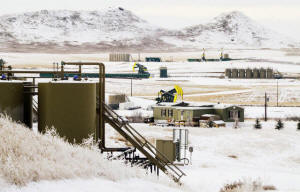|
Leaner and meaner: U.S. shale greater
threat to OPEC after oil price war
 Send a link to a friend
Send a link to a friend
 [November 30, 2016]
By Catherine Ngai and Ernest Scheyder [November 30, 2016]
By Catherine Ngai and Ernest Scheyder
NEW YORK/HOUSTON (Reuters) - In a corner of
the prolific Bakken shale play in North Dakota, oil companies can now
pump crude at a price almost as low as that enjoyed by OPEC giants Iran
and Iraq.
Until a few years ago it was unprofitable to produce oil from shale in
the United States. The steep slide in costs could encourage more U.S.
shale output if OPEC members cut supplies, undermining the producer
group's ability to boost prices. OPEC ministers meet Wednesday to weigh
output cuts to end a two-year glut that has pressured global oil prices.
In shale fields from Texas to North Dakota, production costs have
roughly halved since 2014, when Saudi Arabia signaled an output
free-for-all in an attempt to drive higher-cost shale producers out of
the market.
Rather than killing the U.S. shale industry, the ensuing two-year price
war made shale a stronger rival, even in the current low-price
environment.
In Dunn County, North Dakota, there are around 2,000 square miles where
the cost to produce Bakken shale is $15 a barrel and falling, according
to Lynn Helms, head of the state's Department of Mineral Resources.
"The success in Dunn County has been fantastic," said Ron Ness,
president of the North Dakota Petroleum Council.
Dunn County's cost is about the same as Iran's, and a little higher than
Iraq's. Dunn County produces about 200,000 barrels of oil a day, about a
fifth of daily production in the state.

It is North Dakota's sweet spot because it boasts the lowest costs in
the state, yet improved technology and drilling techniques have boosted
efficiency for the whole state and the entire U.S. oil industry.
The breakeven cost per barrel, on average, to produce Bakken shale at
the wellhead has fallen to $29.44 in 2016 from $59.03 in 2014, according
to consultancy Rystad Energy. It added that in terms of wellhead prices,
Bakken is the most competitive of major U.S. shale plays.
Wood Mackenzie said technology advances should further reduce breakeven
points.
Landlocked Bakken producers still need a substantially higher
international price than their breakeven cost to make a profit, since
they pay more to transport crude to market than producers in most other
U.S. regions.
International oil prices of $45 a barrel are enough for some Bakken
producers to profit, Ness said, and $55 would encourage production
growth.
Benchmark Brent prices plummeted from nearly $116 a barrel in mid-2014
to just $27 earlier this year. Prices have since recovered to nearly
$46. That is still too low for members of the Organization of the
Petroleum Exporting Countries, whose state budgets depend on petrodollar
revenues that plummeted during the price war.
[to top of second column] |

Pumpjacks and other infrastructure for producing oil dot fields
outside of Watford City, North Dakota, U.S. on January 21, 2016.
REUTERS/Andrew Cullen/File Photo

For OPEC ministers meeting in Vienna on Wednesday, a major concern
is that an output cut would encourage a quick response from U.S.
shale producers, who have slashed costs and have been steadily
adding drilling rigs.
"Right now, OPEC understands we're in a push-and-pull experiment
with the United States," said Michael Tran, director of energy
strategy at RBC Capital Markets in New York.
"Two years ago, we thought prices hovering around $50 to $60 meant
that non-OPEC production growth would end. But U.S. production came
back stronger."
In a recent earnings call, Hess Corp said it has improved its cost
performance in the Bakken, with well costs falling and initial
production rates rising, though it did not give more details.
"Everybody is drilling wells faster and completing them better,"
said Mike Breard, an energy stock analyst at Hodges Capital
Management in Dallas. "It's not just a Bakken phenomenon."
Breard said he prefers shale stocks in the Permian basin in Texas,
where he is expecting more big gains in production next year. He is
eyeing firms such as Parsley Energy Inc, Ring Energy Inc and Matador
Resources Co.
Oil companies are already investing big money to benefit from
shale's resurgence. Tesoro Corp recently snapped up Western Refining
Inc in a $4 billion deal to bulk up its exposure in Texas.
Separately, trading firm Castleton Commodities International LLC
bought more than $1 billion in assets from Anadarko Petroleum Corp
to increase its stake in East Texas.
Occidental Petroleum Corp's top executive recently said that company
has enjoyed steady improvement in well productivity and lower
drilling and completion costs in the Permian Basin.

"Simply put, we can deliver more production with fewer wells," Vicki
Hollub, the company's president and chief executive, told analysts
on a recent call.
(Additional reporting by Lewis Krauskopf in New York; editing by
Simon Webb and David Gregorio)
[© 2016 Thomson Reuters. All rights
reserved.]
Copyright 2016 Reuters. All rights reserved. This material may not be published,
broadcast, rewritten or redistributed. |